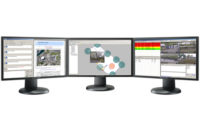Your bracelet is ringing. It’s your home alarm system calling.
Wearables — a mashup of fitness, location, tracking, healthcare and security, these devices now embed in wristwatches, bracelets and other jewelry, shirts and even smart socks. They communicate via cellular as a standalone system, or work with a host smartphone, often talking via Bluetooth or, more rarely, near field communications mode.
They combine with PERS and mPERS (personal emergency response and mobile personal emergency response systems); they can be part of home and personal security systems, as well as work with central monitoring services.
“Wearables will be anywhere you can put a sensor and power unit,” contends Research Analyst James Moar at Juniper Research.
Harry Wang, digital health analyst at Parks Associates, sees an even broader horizon. “Multi-sensor designs. More accelerometers. More gyroscopes. More sophisticated software. Wearables will ‘learn’ home behaviors and predict risk factors and wellness status,” Wang predicts.
The original wearable is the “I’ve fallen” pendant. Sold directly by manufacturers (Philips Lifeline has the lion’s share) or through doctors, healthcare facilities and security dealers, pendants are evolving into wristbands, smart watches, jewelry and smartphone apps. Older folks don’t want to be visually tagged as old with a pendant hanging around their neck, observes Laurie Orlov, founder of Aging in Place Technology Watch. Undoubtedly, there will continue to be a blending of fitness, wellness, home healthcare, aging in place, home and personal security, Orlov says. “But don’t call them medical devices. Those require vastly more [government] approvals.”
Adds Wang, “The different stages and conditions of life will help determine the form of the wearable.”
More generally, 20 percent of American adults already own a wearable device, according to the PriceWaterhouseCooper (PwC) Wearable Future report, which identifies three top benefits:
• improved personal safety and security
• healthier living
• simplicity and ease of use
Still, there are some challenges. “It will be critical to address consumer concerns such as cost, privacy and ease of use,” says Vaughn Kauffman, principal, PwC Health Industries, especially as wearables embrace the Internet of Things (IoT). (Visit www.SDMmag.com to read “Beyond the IoT Hype” for updated commentary about IoT’s impact specific to home security, the smart home and appliances.)
The key to wearables as part of a security or smart home business is finding ways of monetization, of course. Wearables already have a strong incumbent challenger — the smartphone — which, for some, is the wearables’ host. Smartphones can receive and control alarms and security video, and control smart home components as they play an expanding role with security dealers.
Among wearable considerations, Mike Pegler, principal, PwC U.S. technology practice, advises:
• Envision how wearables can create new business opportunities by blending personal security and medical alerts, providing more robust data collection, offering insights into user interaction, and tying in with services in the cloud.
• Keep human-centered design in your strategies.
• Instill trust. For security firms, that trusting relationship may already exist.
• Recognize that wearables continue to evolve, so take a long view.
One example of wearables is SmartTek Systems of Boca Raton, Fla., which has smartphone apps for its security dealer and monitoring partners. Mark Fischer, the firm’s technical consultant, describes it as panic, safety and mobile PERS with a suite of tracking and monitoring protocols. One SmartTek twist is CommBadge (CommBadge Technologies, Laguna Niguel, Calif.), a wearable Bluetooth speakerphone. Users place and answer calls, send and receive text-to-speech messages and can be notified of alarms, calls, texts and events with customizable voice prompts, vibration, sound and LEDs.
Fischer advises to focus on the data, not the device. The future in his eyes involves leveraging datacollect. Central stations will be more a data hub with diverse sources of data.
Another example is the Lively Safety Watch (from Lively, San Francisco), which includes a button for 24/7 emergency response through an in-home hub with built-in cellular connectivity, missed medication reminders, a pedometer and more.
For clients seeking wearable bling, Sense6 Design of Redwood City, Calif., has jewelry in sterling silver, gold and palladium that connects to emergency services, GPS location and audio during an event.
Wearables can work within a security business and with enterprise clients, too. For instance, smart glasses may become an in-the-field asset, replacing tablets and laptops to display installation instructions and manuals. Moar predicts Google competitors will soon offer smart glasses well under $1,000, although “prime uses today are in logistics and energy,” he says. Then there is a wearable bracelet (Toronto-based Bionym’s Nymi) that uses an electrocardiogram biometric to grant access to devices, doors and bank accounts.






